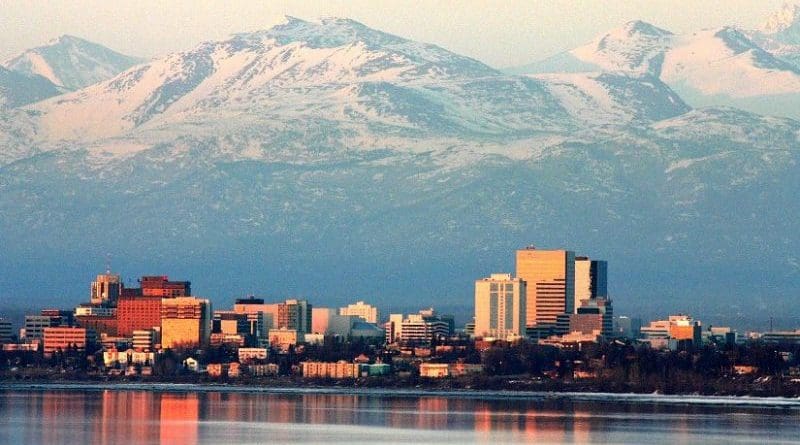Why Alaska Is Critical To America’s Security Strategy – Analysis
Alaska and its peninsula are a unique geographical feature. While the peninsula juts into the North Pacific Ocean, the US state’s northern circumpolar shores are on the increasingly contested Arctic waterways. In the Pacific Ocean security environment, Alaska is at the forefront of the US security paradigm regarding this tremendous northern water mass. Satellite pictures of the Pacific Ocean can be positioned to show that absolutely no significant landmass exists at all, illustrating the depth of the outlook.
The US looks at Alaska as part of the foundation of the larger Indo-Pacific region and the Arctic by creating an arc of protection and projection. There are, especially to the West, many dangers, as demonstrated by North Korea.
Alaska, with its Pacific and Arctic presence, is also part of America’s security considerations as affected by climate change. Climate change is changing the strategic picture in the north. The ice pack is melting and there is a viable Northwest Passage across the Canadian-US Arctic coast for much of the year. Permafrost is now not so permanent and a scramble for resources in the region might match the same type of activity seen around other Pacific Ocean nations.
For the US, Alaska is a critical region for both power projection and homeland defense.
The importance of the region only grows as the impacts of climate change accelerate. Temperatures are beginning to change, affecting military infrastructure. So, while planning and conducting strategic and tactical missions in the Pacific and Arctic, the weather and its impact on geography become an important aspect. Military infrastructure in the region is built on permafrost foundations that are now melting, while coastal erosion impacts radar sites, so repairs are part of the daily routine.
The Pacific Ocean economy, in which Alaska finds itself, is highly contested along particular coastlines. The changing nature of the sea and of coastal communities impact the way other countries’ navies operate as they cross into Alaska’s over-the-horizon strategic viewpoint. The increased geopolitical activity by China and Russia is at the forefront of the Pacific Ocean security paradigm, with North Korea also taking a specific front-row seat.
To be sure, Russia has the largest Arctic landmass facing America and only about 80 km separates one side of the Bering Strait from the other at its narrowest point. Russia’s presence in the northeast Pacific cannot be ignored, especially regarding US allies such as Japan and South Korea. The growth of possible contingencies involving Russian activity in the Pacific needs constant revision because of Moscow’s future trajectory.
Meanwhile, China, the main strategic competitor of the US, is thousands of miles deep into the Pacific. The Chinese navy has, for decades, been going to the Pacific ports of Central and Latin America. Beijing’s understanding of the Pacific region is an important part of how the US and its allies may respond in a contingency. China will also now be able to assert itself in the Arctic thanks to the signing last month of a special border control agreement with Russia that covers the length of Russia’s northern maritime passage. Chinese naval ships will now be transiting the Bering Strait. If you live in Alaska, you may be able to see Beijing’s navy outside your window, with Russia in the background.
The presence of both Russia and China close to Alaska predates the 2022 Russian invasion of Ukraine. Russian long-range aviation patrols around Alaska’s Air Defense Identification Zone, which surrounds the state but is not US territorial airspace, restarted in 2007. And US officials have revealed that the number of intercepts of those flights in 2020 was at its highest level since the Cold War. Chinese warships were spotted off Alaska’s coast for the first time in September 2015 and Chinese icebreakers are making more trips to the Arctic, often passing through the Bering Strait. Such actions by Moscow and Beijing were all taking place before the European war that started in February last year.
An important historical lesson about the Alaska Peninsula comes into play when thinking about Pacific maritime and island security. The Second World War Aleutian Islands campaign — a yearlong battle — is worth examination. The islands of Attu and Kiska were the only North American territory captured during the war and retaking them required brutal fighting in frigid, rugged conditions. Japanese troops headed to the Aleutians in May 1942 as part of a plan to lure the US Navy into a trap during the Battle of Midway. The Aleutian battle is largely forgotten, but the lessons learned require review in the coming years.
Overall, Alaska and its landmass are critical to US security strategy, especially in the circumpolar regions and the bulk of the Pacific Ocean maritime domain, from a land-based perspective. Contested islands are part of today’s warfare environment and history tells us, in a repetitive way, what type of contingency is coming. But Alaska also offers a way for the US to protect against the overall trend lines found in the Pacific Ocean domain.

